Bass clef notes for piano

In order to fix the middle and low notes in sound, a bass clef is placed at the very beginning of the staff. Its image begins with a curl on the fourth line (horizontal stripes are counted from bottom to top). On the same line is the "fa" notation. It belongs to the minor octave. Other notes are built from it. The bass clef is used to record low and high octaves, counter octaves. After the same key, 5 symbols of the first octave and 2 signs of the subcontroctave are also placed.
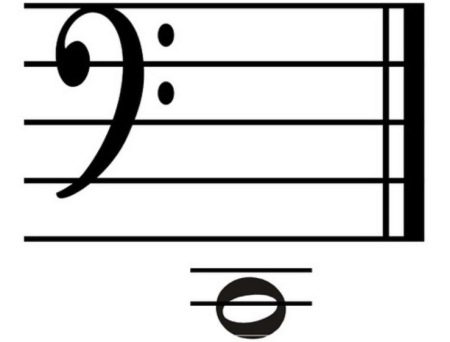
Minor octave notes
The graded scale contains 9 octaves, separating sounds in pitch. Some are not complete without the use of a piano bass clef. It is required when denoting a small octave. The reference point is the note "F", depicted on the fourth line. It serves as a kind of reference point, since by its location you can easily calculate, memorize and read all the other symbols on the staff. This sign is surrounded by "mi" (just below) and "salt" (just above). Logically, we can come to the conclusion that the note "re" is on the third line, and the sign "la" takes its position on the fifth straight staff.
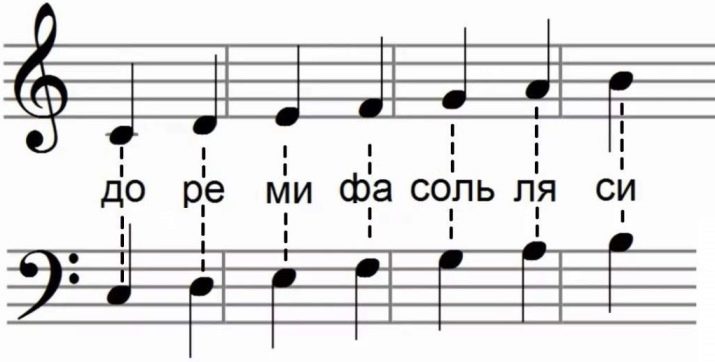
Minor octave signs fit on the top three lines of the main space of the staff. All signed characters should be examined carefully first. Minor octave notes have the following arrangement on the staff:
- "Before" is under the third line;
- "Re" - on the third line;
- "Mi" - under the fourth ruler;
- "Fa" - right on the fourth strip;
- "Salt" - under the fifth line;
- "La" - on the fifth line;
- "Si" - over the fifth line.
These notes are often used in piano music.

Big octave
The notes of the major octave of the bass clef are depicted on the staff on the left side of the minor octave. To fix in order all the note signs of a large octave, two lower staff lines and auxiliary lines are required:
- "Before" is placed on the second additional line in the lower part;
- "Re" takes place under the first additional line;
- "Mi" is depicted directly on the first auxiliary line;
- "Fa" is under the first main ruler;
- "Salt" is prescribed directly on the first main strip of the staff;
- "La" takes its position between the first and second line;
- "Si" is strung on the second ruler of the staff.
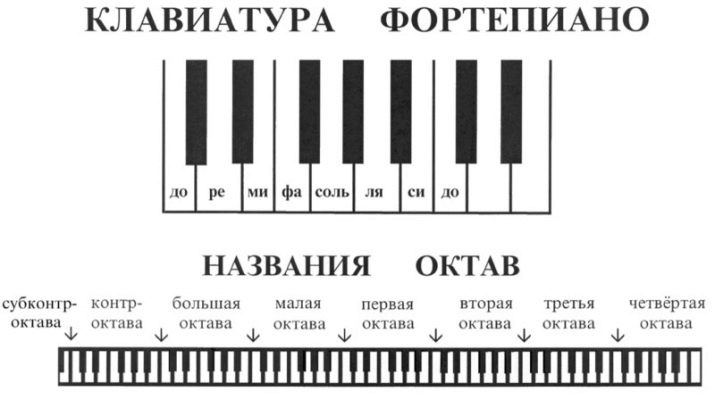
Other notes
The notes of the first octave are only partially fixed in the bass clef on the auxiliary lines in the upper part of the staff. Only 5 signs of this part of the scale:
- "Before" takes a position on the first additional line above;
- "Re" is located on top of the first auxiliary line (directly above it);
- "Mi" is depicted directly on the second additional top line;
- "Fa" is placed above the second additional strip;
- "Salt" is prescribed directly on the third auxiliary ruler (this note is used in exceptional cases).
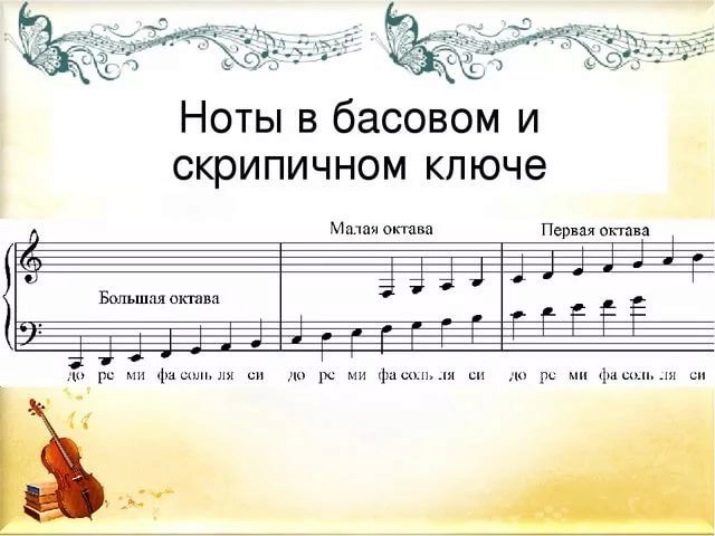
The sound series of the controctave for playing the piano is used very rarely.
Music marks are usually placed on additional lines. An octave dotted line is often used, consisting of the usual dotted line, which is marked at the beginning of the staff with the number 8. The dotted line encircles all lower notes. It saves the recording from a huge number of additional lines, but slows down the process of recognizing note signs, making the recording cumbersome.
Without using the octave dotted line, the main characters of the controctave are denoted as follows:
- "Before" is located under the fifth auxiliary line in the lower part;
- "Re" is strung on the fifth additional line;
- "Mi" is under the fourth lower auxiliary strip;
- "Fa" is strung directly on the fourth additional line;
- "Salt" is placed under the third auxiliary line;
- "La" takes a position on the third lower additional ruler;
- "Si" is depicted under the second auxiliary line of the staff.
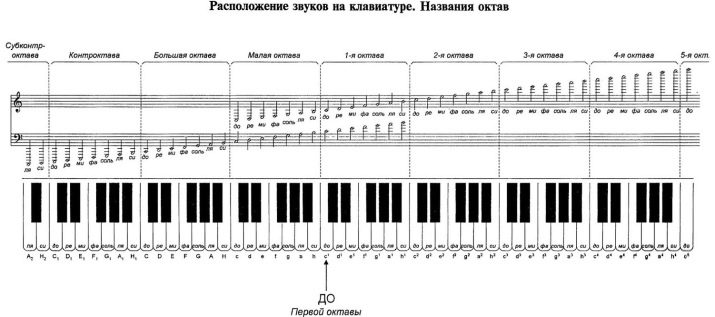
The subcontroctave consists of only two note signs: "la" and "si". An incomplete octave, consisting of the lowest notes, is used in the rarest of cases. Fixation is performed using an octave dotted line, signed by the number 15. This means that you need to use notes as much as 2 octaves lower.
How to quickly learn?
To memorize the note symbols of the bass clef, you must always focus on the fourth line of the staff. It is on it that you can see the "F" note of a small octave. You can quickly fix note symbols in memory by three notes "C". When it comes to a large octave, this note sign is depicted on the second additional line at the bottom. The minor octave suggests its location between the second and third major rulers. And to designate the first octave, the "C" sign is located on the first auxiliary ruler at the top.
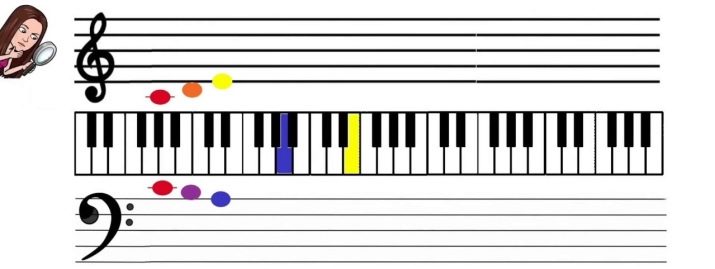
Bass clef notes are designed to be played with the left hand, which usually acts as accompaniment. Most often chords are used. They should be played simultaneously, alternately, or in a different order.
There are various special exercises designed to quickly memorize the notes of the bass clef. Practical exercises allow the beginner to quickly understand difficult issues. They contribute to the development of an ear for music. With a variety of practical activities, anyone can learn to play the piano.

For the purpose of quickly assimilating the location of note signs, it is best to use the phrases “under the second line” or “under the fifth line”, and not “between the first and second lines” and “between the fourth and fifth lines”.
There is also an interesting way to easily memorize the note signs strung on each straight horizontal line of the staff from bottom to top, in the form of a quick-speaking row: "Salt" - "si" - "re" - "fa" - "la". These symbols of the major and minor octaves are built through one note. There are other convenient phrases with different note groups. For example, "fa" - "la" - "do", "mi" - "salt" - "si".

The location on the keyboard of a synthesizer or piano can be easily learned by the pasted colored labels. First of all, highlight the "C" key of the first octave with a colored sticker. Then, to the left of this linking note, you need to place 5 more marks on the keyboard at intervals of one key. These 5 keys, marked with the same color, mean the note symbols of the tongue twisters we already know: "salt" - "si" - "re" - "fa" - "la". In this case, the names of the notes themselves are not very important for a beginner. The main point is fixing in memory the correspondence of the note symbols on the staff and the marked keys.
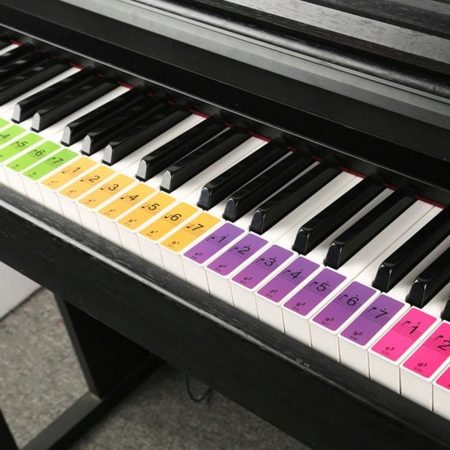
Then try playing all 5 notes. The next step will be practicing three note signs in practice: "re" - "fa" - "la". First use them as a chord by pressing 3 keys at once. Then try alternate pressing, then press the middle note "F" and then press the 2 keys farthest from it. After assimilating the material, you need to do a similar work with the keys between the labels. Next, you need to mark other keys that remain outside the marked notes. Stickers help you quickly memorize parts of the scale in the bass clef.

In the absence of a musical instrument at home, you can practice on a virtual piano on the Internet. Try to delve into the printed sheet music while listening to your favorite song. Thus, a person learns to understand music on an intuitive level. There are various sites, thanks to which you can listen to the work of any composer while viewing the notes of the performed composition.

Filling out cards and special music notebooks, regular training contribute to the rapid memorization of musical pieces. The more a person practices, the easier it is for him to write musical notation.
For information on how to read the notes of a bass clef for piano, see the video below.








